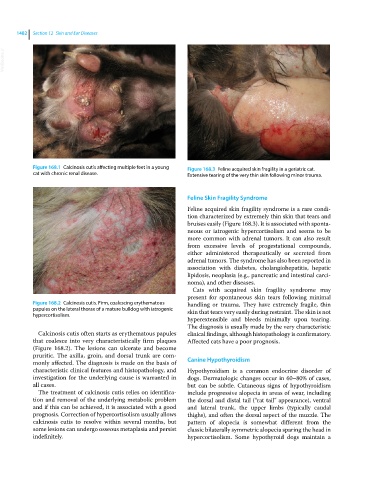Page 1544 - Clinical Small Animal Internal Medicine
P. 1544
1482 Section 12 Skin and Ear Diseases
VetBooks.ir
Figure 168.1 Calcinosis cutis affecting multiple feet in a young Figure 168.3 Feline acquired skin fragility in a geriatric cat.
cat with chronic renal disease. Extensive tearing of the very thin skin following minor trauma.
Feline Skin Fragility Syndrome
Feline acquired skin fragility syndrome is a rare condi-
tion characterized by extremely thin skin that tears and
bruises easily (Figure 168.3). It is associated with sponta-
neous or iatrogenic hypercortisolism and seems to be
more common with adrenal tumors. It can also result
from excessive levels of progestational compounds,
either administered therapeutically or secreted from
adrenal tumors. The syndrome has also been reported in
association with diabetes, cholangiohepatitis, hepatic
lipidosis, neoplasia (e.g., pancreatic and intestinal carci-
noma), and other diseases.
Cats with acquired skin fragility syndrome may
present for spontaneous skin tears following minimal
Figure 168.2 Calcinosis cutis. Firm, coalescing erythematous handling or trauma. They have extremely fragile, thin
papules on the lateral thorax of a mature bulldog with iatrogenic skin that tears very easily during restraint. The skin is not
hypercortisolism.
hyperextensible and bleeds minimally upon tearing.
The diagnosis is usually made by the very characteristic
Calcinosis cutis often starts as erythematous papules clinical findings, although histopathology is confirmatory.
that coalesce into very characteristically firm plaques Affected cats have a poor prognosis.
(Figure 168.2). The lesions can ulcerate and become
pruritic. The axilla, groin, and dorsal trunk are com-
monly affected. The diagnosis is made on the basis of Canine Hypothyroidism
characteristic clinical features and histopathology, and Hypothyroidism is a common endocrine disorder of
investigation for the underlying cause is warranted in dogs. Dermatologic changes occur in 60–80% of cases,
all cases. but can be subtle. Cutaneous signs of hypothyroidism
The treatment of calcinosis cutis relies on identifica- include progressive alopecia in areas of wear, including
tion and removal of the underlying metabolic problem the dorsal and distal tail (“rat tail” appearance), ventral
and if this can be achieved, it is associated with a good and lateral trunk, the upper limbs (typically caudal
prognosis. Correction of hypercortisolism usually allows thighs), and often the dorsal aspect of the muzzle. The
calcinosis cutis to resolve within several months, but pattern of alopecia is somewhat different from the
some lesions can undergo osseous metaplasia and persist classic bilaterally symmetric alopecia sparing the head in
indefinitely. hypercortisolism. Some hypothyroid dogs maintain a

